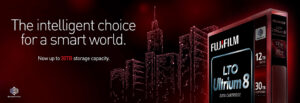Reducing Carbon Emissions through the Data Tape Ecosystem
By Rich Gadomski, Fujifilm, and Paul Lupino and Tom Trela, Iron Mountain

If there was ever a time for industries and governments around the world to come together and finally take steps to mitigate climate change, now would seem to be it. The return of the United States to the Paris Climate Agreement and the recent U.S. – China talks on climate change are all positive signs when it comes to moving the needle forward on sustainability initiatives. While fighting COVID-19 took center stage in 2020 and early 2021, our future depends on what we do collectively to reduce our environmental impact now and in the immediate years ahead.
It’s Hard to Deny Global Warming and Climate Change
According to an article that appeared in the Wall Street Journal earlier this year, NASA has ranked 2020 as tied with 2016 for the warmest year since record-keeping began in 1880. In a separate assessment, NOAA (National Oceanic and Atmospheric Administration), which relies on slightly different temperature records and methods, calculated that the global average temperature last year was the second highest to date – just 0.04 degrees Fahrenheit shy of tying the record set in 2016.
On top of the record number of hurricanes and the wildfires out west, the recent Texas deep freeze, which caused widespread power outages and other weather-related tragedies and calamities, seems to be just one more example of climate change. Weather patterns are becoming more unpredictable, which can result in extreme heat, cold and increased intensity of natural disasters.
It is widely acknowledged that global temperatures have been rising especially in the north polar region where we have seen a dramatic shrinking of the polar ice cap. When Arctic air warms, it sets off an atmospheric phenomenon that weakens the polar vortex (the normal jet stream of wind that keeps frigid air to the north) and allows cold air to fall…as far as Texas.
Data Center Energy Consumption and the Advantage of Modern Tape Technology
The key to mitigating the worst impacts of climate change is a reduction in the amount of greenhouse gases produced by humans. Producing energy is extremely resource-intensive, so reducing the amount of energy we consume in all aspects of our lives is of critical importance.
Data centers are significant consumers of energy accounting for as much as 2% of global demand and rising to 8% by some estimates. Data centers can do their part to reduce energy consumption in many ways by becoming more energy-efficient, including simply migrating the vast amounts of still valuable, but rarely accessed, “cold data”.



